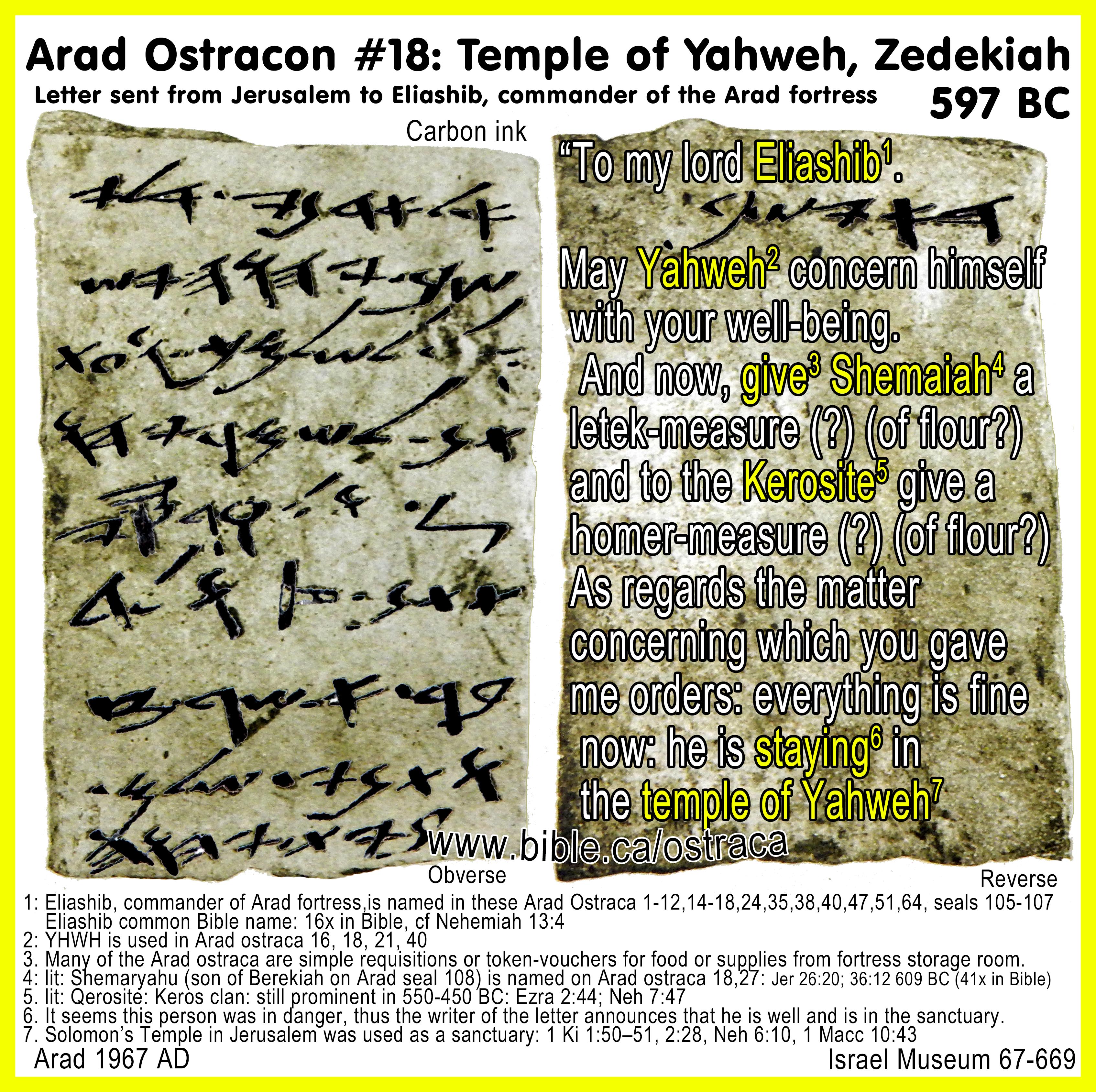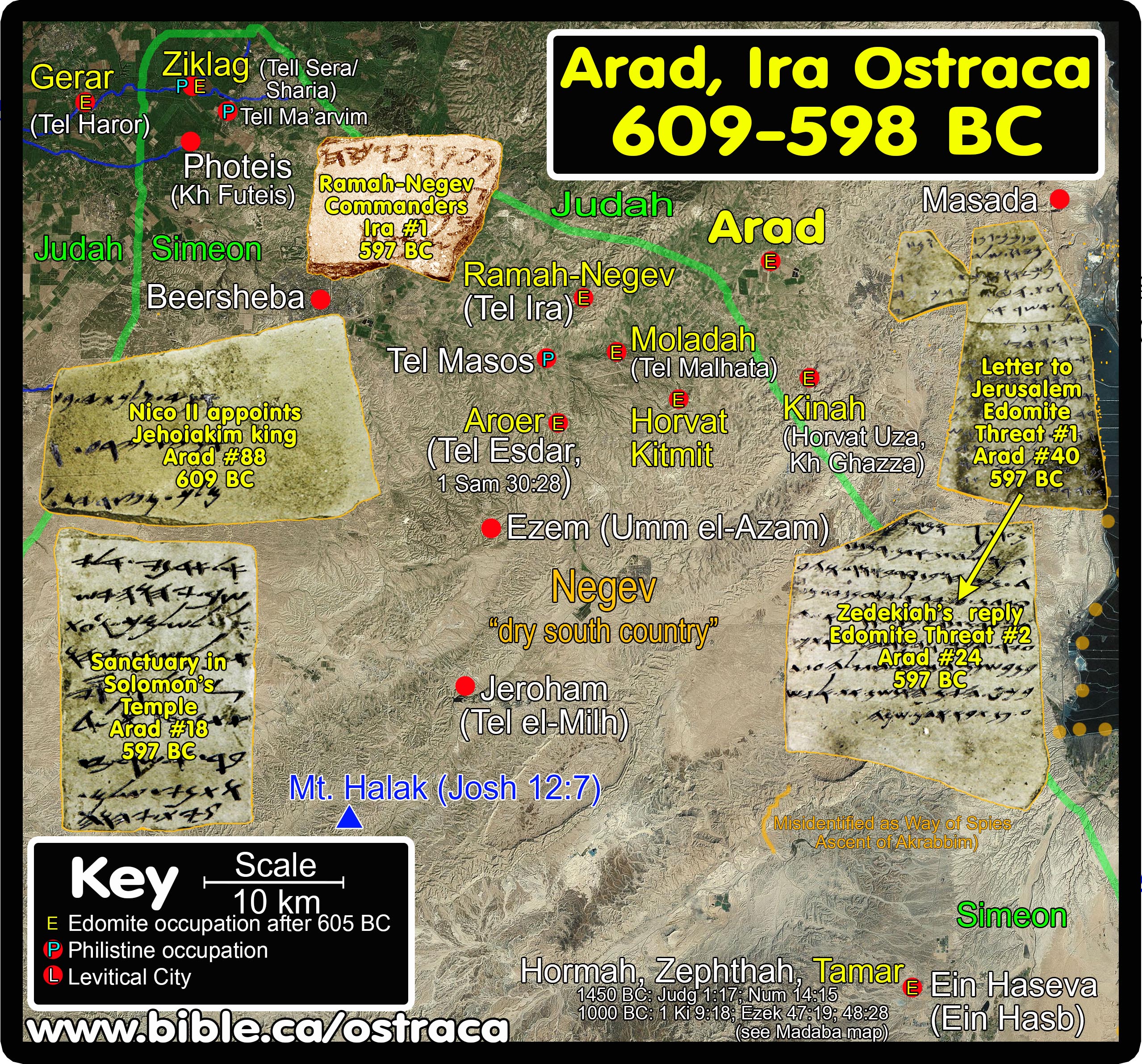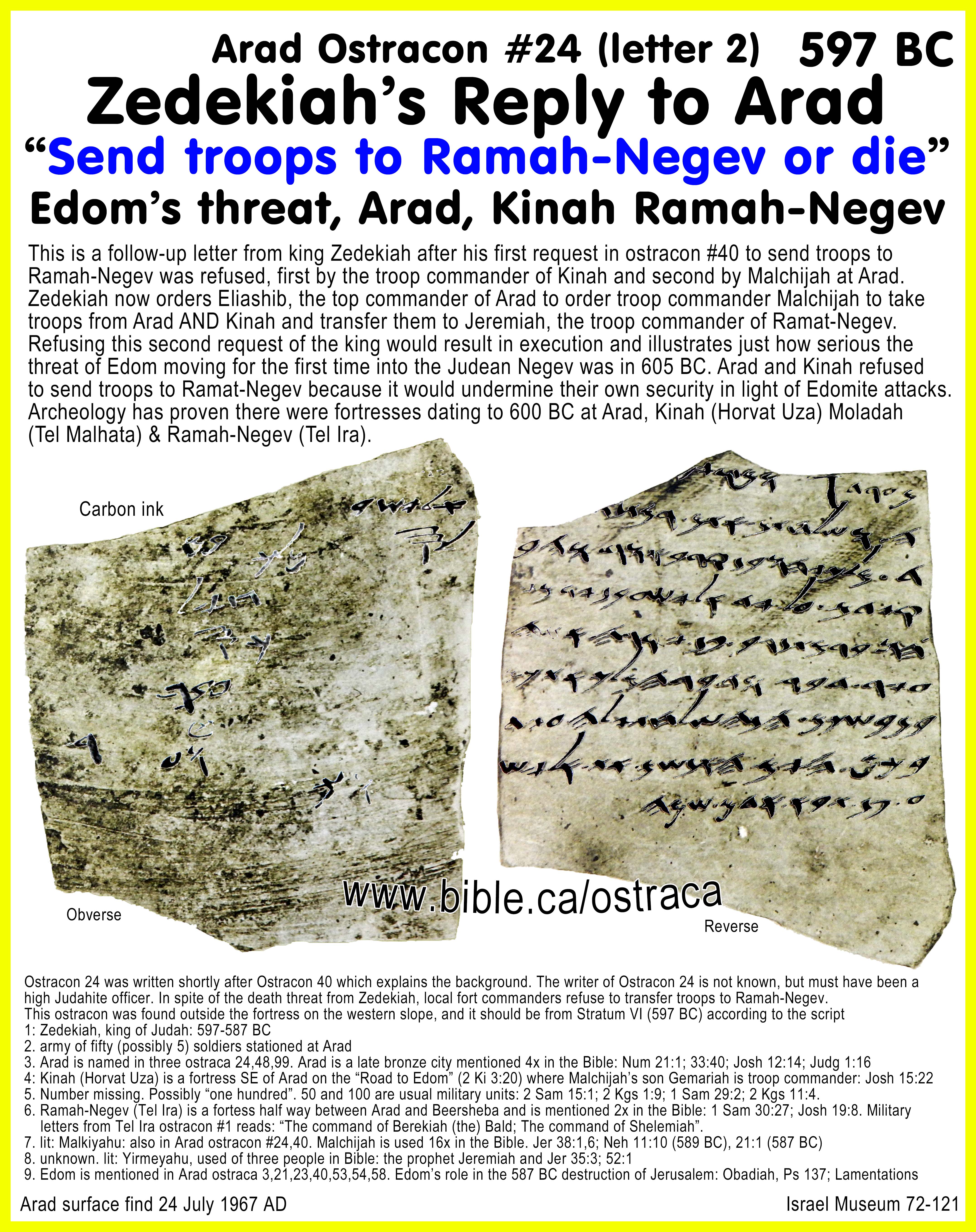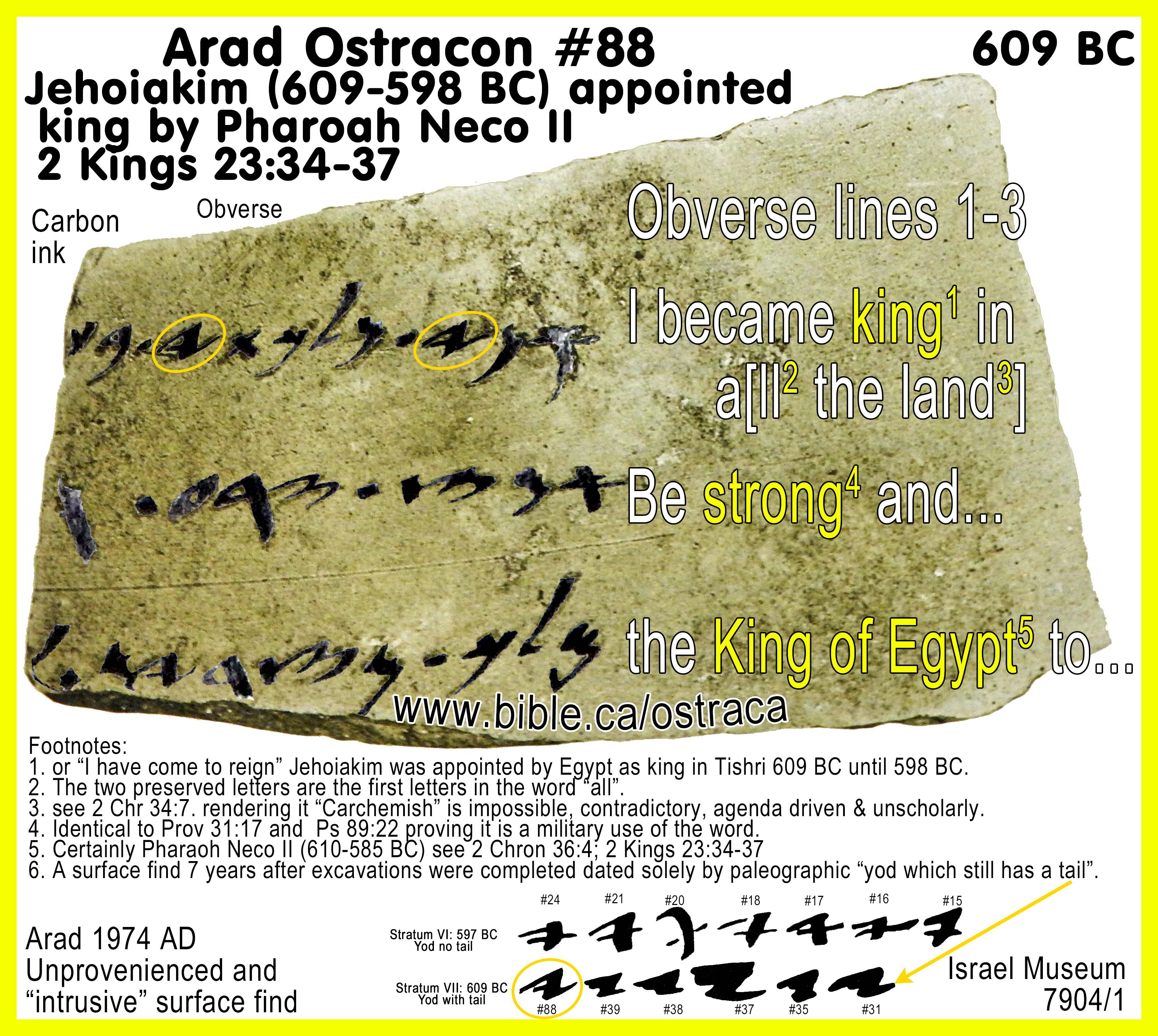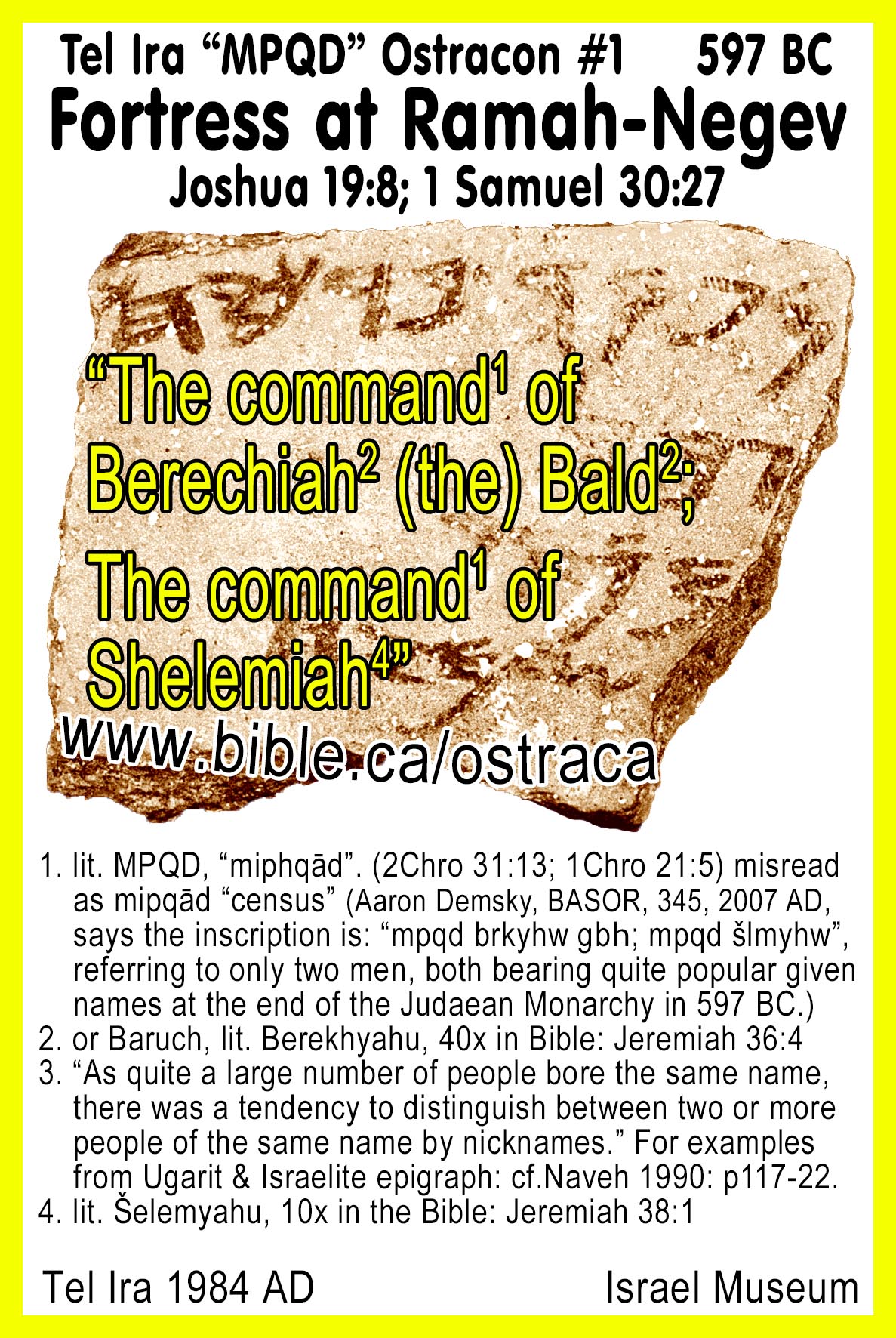Arad Ostraca #18 (597 BC)
Man seeks asylum in Temple of Solomon in Jerusalem at the time of Zedekiah
Ostraca, Tablets and Inscriptions of the Bible
|
Digging up Bible stories! 5 ostraca document 3 important Bible events: 1. Pharaoh Nico II appoints Jehoiakim king of Judah in 609 BC. 2. Edomites move into the Judean Negev and Zedekiah orders troops for defense. 3. A man seeks asylum in the temple of Solomon. See also: Outline on Josiah King of Judah (640-609 BC) Outline on Jehoiakim king of Judah (609-598 BC) Outline on Zedekiah King of Judah (597-587 BC) Outline on Gedaliah 1st Governor of Judah (587 BC) "What we read in the book, we find in the ground" |
Click here for SPECIAL INTRODUCTION TO ALL ARAD OSTRACA
|
|
|
Arad Ostracon #18: YHWH, Solomon's Temple in Jerusalem |
|
|
Introduction to Arad ostracon #18:
- Read first to understand Arad ostracon #18 better: Archeological introduction to Arad Ostraca
- In this archeological glyptic artifact we have a record, on a piece of broken pottery written in carbon black ink, the in 597 BC at the time of Zedekiah, king of Judah (Outline on Zedekiah).
- Arad #18 is important to Bible students because:
- Arad ostracon inscription #18 contains "YHWH" the name of God!
- Arad ostracon inscription #18 mentions the Jerusalem Temple of Solomon from the first temple period.
- Arad ostracon inscription #18 illustrates how the Temple was used for asylum seekers: 1 Ki 1:50–51, 2:28, Neh 6:10, 1 Macc 10:43
- Arad ostracon 18 is a fully provenienced object.
- Translation of Arad ostracon #18:
- “To my lord Eliashib1. May Yahweh2 concern himself with your well-being. And now, give3 Shemaiah4 a letek-measure (?) (of flour?) and to the Kerosite5 give a homer-measure (?) (of flour?) As regards the matter concerning which you gave me orders: everything is fine now: he is staying6 in the temple of Yahweh7 (Steve Rudd adapted from Aharoni)
- For red footnotes see below.
- Brackets […] indicate missing, damaged or unreadable text.
- The Arad ostracon inscription #18 shows the Bible to be a book of valid history at the time Zedekiah was King of Judah (597-587 BC):
I. Arad ostracon #18 connection with the Bible:
- We have the personal name of the Hebrew's God: YHWH written on the pottery sherd in carbon black ink!
- YHWH is used in Arad ostraca 16, 18, 21, 40.
- We have direct reference to the Temple of Solomon in Jerusalem.
- Solomon’s Temple in Jerusalem was used as a sanctuary for refugees to seek asylum: 1 Ki 1:50–51, 2:28, Neh 6:10, 1 Macc 10:43
- "And Adonijah was afraid of Solomon, and he arose, went and took hold of the horns of the altar. Now it was told Solomon, saying, “Behold, Adonijah is afraid of King Solomon, for behold, he has taken hold of the horns of the altar, saying, ‘Let King Solomon swear to me today that he will not put his servant to death with the sword.’ ”" (1 Kings 1:50–51)
- "Now the news came to Joab, for Joab had followed Adonijah, although he had not followed Absalom. And Joab fled to the tent of the Lord and took hold of the horns of the altar." (1 Kings 2:28)
- "When I entered the house of Shemaiah the son of Delaiah, son of Mehetabel, who was confined at home, he said, “Let us meet together in the house of God, within the temple, and let us close the doors of the temple, for they are coming to kill you, and they are coming to kill you at night.”" (Nehemiah 6:10)
- "And all who take refuge at the temple in Jerusalem, or in any of its precincts, because they owe money to the king or are in debt, let them be released and receive back all their property in my kingdom." (1 Maccabees 10:43)
II. Translation of Arad ostracon #18:
|
“To my lord Eliashib1. May Yahweh2 concern himself with your well-being. And now, give3 Shemaiah4 a letek-measure (?) (of flour?) and to the Kerosite5 give a homer-measure (?) (of flour?) As regards the matter concerning which you gave me orders: everything is fine now: he is staying6 in the temple of Yahweh7 (Steve Rudd adapted from Aharoni)
For red footnotes see below. Brackets […] indicate missing, damaged or unreadable text. |
|
|
Steve Rudd's red footnotes from his adapted translation above
|
|
A. Translation from COS: “To my lord Elyashib. May Yahweh concern himself with your well-being. And now, give Shemaryahu a letek-measure (?) (of flour?) and to the Qerosite give a homer-measure (?) (of flour?) As regards the matter concerning which you gave me orders: everything is fine now: he is staying in the temple of Yahweh" (Arad 18: A Letter From One of Elyashib’s Subordinates, COS 3.43I, 2003 AD)
B. Translation notes from: Arad Inscriptions, Yohanan Aharoni, Arad inscription 18, p 35, 1981 AD
Aharoni translation: " To my lord Eliashib, May the Lord seek your welfare, and now: Give to Shemaryahu a lethech (?), and to the Kerosi give a homer (?), and as to the matter which you commanded me — it is well; he is in the house of God." (Arad Inscriptions, Yohanan Aharoni, Arad inscription 18, p 35, 1981 AD)
1. The excavation reports for Arad Ostracon #18 are:
a. Arad was excavated 1962-1967 AD.
b. Arad Inscriptions, Yohanan Aharoni, Arad inscription 40, p 70, 1981 AD (The Hebrew version was published years earlier, but the English edition has many updates and corrections)
c. Three Hebrew Ostraca from Arad, Y. Aharoni, BASOR 197, p 28, 1970 AD
2. "This letter was sent by one of Eliashib's inferiors, as can be seen from the form of the opening formula. The name of the sender was not written; from the contents of the letter, it seems that the sender was on a mission for Eliashib, apparently in Jerusalem, from where he sent the letter to his superior officer. Thus the name of the writer was known to Eliashib; possibly his name was given by the messenger who delivered the letter. It was the same in the Lachish letters; there, too, a subordinate sent letters to this commanding officer and the name of the sender is given in only one of the letters (No. 3)" (Arad Inscriptions, Yohanan Aharoni, Arad inscription 18, p 35, 1981 AD)
B. Line by line commentary: Arad Inscriptions, Yohanan Aharoni, Arad inscription 18, p 35, 1981 AD
1. Line 1. To my lord Eliashib this is similar to the opening formula of some of the Lachish letters (No. 2, 4).2
2. Lines 2-3. May the Lord seek your welfare — this is an ancient formula known already from the Canaanite period.3 It should be noted that it is a different opening from that used in the Lachish letters. Lacking additional examples, we can only ask whether the choice of formula
3. was accidental and depended on the taste of the writer, or whether different formulas were used in different administrative branches, such as military administration in Lachish and perhaps civil administration at Arad.
4. Line 4. — a direct imperative, as in Inscriptions 3 and 4. At first glance, it is surprising that a subordinate should give orders to Eliashib, however it is possible to learn from this something of the arrangements for issuing supplies. Persons sent on state missions, here apparently to Jerusalem, are provided with a letter in which are detailed the provisions which they should receive on the way (at Arad). This letter is a sort of requisition-voucher which is a matter not pertinent to the rank of the writer in relation to the rank of the recipient (Eliashib). On the other hand, it is clear that the writer of the letter is part of the governmental administration; and as Eliashib's subordinate, he alone has the authority to handle these requisitions. [The use of the imperative to one superior in rank should not be surprising. Imperatives are addressed to God in the Psalms (AFR).] Sometimes the writers take advantage of the opportunity and add other things to the letter. If the writer ranked higher than Eliashib, he would add instructions and orders; if he were of lower rank, such as in this case, he would add information and a report on his actions and on the tasks assigned to him. Shemaryahu (Shemeriah) — several people of this name are known from the Bible, from the time of David up to the time of Ezra,4 and the name appears in the Samaria ostraca written.
5. Line 5. — what Shemaryahu was supposed to receive at Arad was written only as a sign whose meaning is uncertain. Albright compared it to the hieratic sign for the area measure (1/2 aroura), and assumed that Shemaryahu was supposed to receive a piece of land outside of the fortress, perhaps in order to build a house and garden.6 This is a far-fetched proposal; it is more likely that here again the subject of the letter is the supply of provisions (food), as in the other ostraca. This sign also appears in four other ostraca (Nos. 31, 33, 42, and 84; vid. the table of signs, p. 138), which further strengthens our supposition. Especially important is its appearance five times in Inscription 31, which is a list of grain. Thus it seems that here too a certain amount of wheat is meant. Comparing the signs of the different ostraca, one can propose that this is the sign for the lethech, which is half a homer (vid. Inscription 31:2). The sign appearing in line 6 here is apparently the sign for the homer, and cf. Inscription 1:7. Thus we may assume that Shemaryahu received half a homer, that is, five ephalis. This is quite an amount of wheat (or Hour), and in comparing this amount with Inscriptions 1 and 2, it can be deduced that about 225 loaves of bread were made from it (see below p. 145). Thus it seems that these provisions were not meant for ShemaryaInt alone, but for 011)(4 people, too, who were with him. One may assume that he was the head of a troop, sent 'with his forces to one of the fortresses in the Negeb. The Kersosi -- a member of the Kei os family, known from the Bible (Ezra 2:44; Neh 7:47). This is the first mention of one of the names of families of Nethinim in the First Temple Period, which strengthens the tradition in 1 Chronicles 9:1-2 regarding their ancient origins.
6. The gentilic form and the fact of his being on a mission at Arad support the hypothesis that at the time of the monarchy, the Nethinim were no longer Temple slaves of inferior degree, but held a position as professionals connected with religious functions.
7. Line 6. — this sign is identical to that which appears in Inscription 1:7 as a unit of flour, which we interpreted as the homer measure.9 This fits the appearance of the previous sign in the list of grain. Thus it would appear that the Kerosi received one homer of wheat or flour, in contrast to the half-homer that Shemaryahu received. This is a large amount (that was enough for baking 450 loaves of bread, vid. above, Inscription 1:7). So it seems that the Kerosi was not alone, but appeared as the representative of a larger unit of men. Since he is mentioned by family name alone, connected to his family's role in the ritual, we may assume that this was a group of Nethinim sent to the area for some cultic purpose. Unfortunately, there are no further details; however, from the continuation of the letter and from the mention of "the house of the Lord" in line 9, it appears that Eliashib's command was connected in some way with the Temple. This may be linked to the fact that the "house of the Lord" at Arad existed up to Stratum VII, and was destroyed finally during the reign of Josiah, about a generation before this letter was written. Even though the sanctuary at Arad was no longer rebuilt, some of the priestly administrative duties were still performed, no doubt, as before, such as the collection of tithes. Probably during the time of Jehoiakim and Zedekiah there was a partial relapse from the great reform of centering the cult in Jerusalem ("And he did that which was evil in the sight of the Lord" — 2 Kgs 23:37; 24:19; 2 Chr 36:5,12). The dispatch of a group of men under the Kerosi perhaps can be understood as a renewal of certain ritual practises outside of Jerusalem, but there is no further proof of this.
8. Lines 6-10. The reading of the eight words is uncertain; however, the relationship of the words and their meaning can be interpreted in various ways. In the preliminary publication, I wrote as follows:" "The meaning is: 'As to the matter which I have commanded — it is well' — that is, the thing is done, all is well. 'He (the man commanded) sits (in peace) in the house of God.' For the expression instead of 31:1, cf. Jer 36:22; vid. Num 21:1 in contrast to Num 33:40. "A second possibility, less likely. is to combine the word to the words following it, and to interpret thus: `As to the matter which I have commanded — it will restore the peace Of the house of the Lord' (or else DIM means an altar for peace offerings). Perhaps Eliashib commanded his messenger to request help for the rebuilding of the sanctuary at Arad and received promise that indeed it would he restored? But this is a difficult interpretation. Especially working against it is the exaggerated space between at the beginning of the next line."
a. "Since then, several scholars have discussed this section. Freedman, Otzen, and Lemaire accept my interpretation basically, but suggest the verb "paid" instead of the noun "peace", and Freedman compares it to the verse "So he finished the house" (1 Kgs 9:25). It seems to me that this proposal does not solve the linguistic problem, but exacerbates it. The verb is a transitive verb, and as such what would have been needed is "the thing has been finished". In contrast, the noun is common and is usually followed by the preposition "to" (7). It is true that usually peace is to someone, and not to something, however I see no difficulty in interpreting it as an abbreviation. From the continuation, we know that a person is meant ("he sits in the house of the Lord"). Thus the following interpretation seems likely: (15) Eliashib's instructions concerned a certain person. It seems that this person was in danger, thus the writer of the letter announces that he is well and is in the sanctuary.14"
b. "Several other interpretations have been suggested for the word. Levine tended to translate it as "an altar for peace-offerings" He read in the (cf. 2 Kgs 3:4; 17:3). He referred the reader to biblical verses dealing with "returning" an offering to God, such as "What shall be the guilt-offering which we shall return to Him?" (1 Sam 6:4), "And he shall make restitution for his guilt in full... but if the man have no kinsman to whom restitution may be made for the guilt, the restitution for the guilt which is made shall be the Lord's" (Num 5:7-8). He translated the passage in the ostracon: "He will remit the offering of the Temple of Yahweh." This interpretation poses several difficulties. restitution of guilt-offerings appears in the Bible, whereas peace-offerings are "raised" (2 Sam 6:17 etc.). It seems this is not by chance, but that the instruction "special task of the guilt-offering."' Two verbs in the appear in both cases, they written in plebe writing. Since the letters air contemporary, we would expect that in this ostracon, too, the for would he written with."
c. "And what of the three words preceding, Albright reads, assuming that the sanctuary of Arad was meant, and thus he connects the three words to the previous sentence, translating: "...and to the sanctuary (give) what thou didst recommend to me. As for Shalfum, he shall stay at the temple of Yahweh." This interpretation is difficult to accept is the Holy of Holies of the Temple,18 and there is no evidence that this word can he used to mean the whole temple, in the way the can. As noted in the preliminary publications,' the temple of Arad was destroyed before Stratum VI, and no longer existed at the time when these ostraca were written. Even if we were unsure of this fact by virtue of our analysis of the excavations, it would be difficult to believe that after Josiah's reform a temple could have existed at Arad. At any rate, the verb ma cannot be translated "recommend". It clearly means "order, command". Eliashib's subordinate refers to specific instructions given him, and he has no need to write to his master that he will give to the temple of Arad what Eliashib has commanded him.
d. Thus it seems impossible to accept the foregoing proposals. As such, I maintain my former position, with a small correction, and read: "And as to the matter which you have commanded me — it is well; he sits in the house of the Lord."
e. [Subsequently, B. Levine, Shanaton 3 (1978), 289, has withdrawn his proposal discussed above. He cites 2 Kings 4:23 as an example of the word falom in the meaning, "it's all right," "its OK." This is basically Aharoni's understanding of the passage and makes perfect sense. AFR]
f. It appears that the instructions of Eliashib concerned a man whose life was in danger.21 The writer writes that all is well and he is alive in the Temple. The two matters are connected — the man had found a sanctuary in the Temple.
g. The role of the Temple as a sanctuary is hinted at in various passages (1 Kgs 1:50-51; 2:28; Neh 6:10; and especially 1 Mace. 10:43). These verses speak of the Temple at Jerusalem, but it appears that other temples also served as sanctuaries, such as the altar at Ramah (1 Sam 19:18) and the temple Beer-Sheba (1 Kgs 19:3). It is true that not only the Temple at Jerusalem was called the "House of Yahweh", but also other Yahwistic temples, such as the one at Shiloh (1 Sam 1:7), apparently the temple at Shechem (Josh 24:26), and also the temple at Arad. However, it should he remembered that these letters are from the end of the First Temple Period, there is no reason to believe that there were temples in existence at that time aside twin the temple in Jerusalem. There is no doubt that the "House of Yahweh's discussed is none other than the Temple at Jerusalem, and that Eliashib's subordinate was sent there by his master. It should be noted that this is the first epigraphic reference to the temple.
C. Footnotes: Arad Inscriptions, Yohanan Aharoni, Arad inscription 18, p 35, 1981 AD
1. Footnote 21: It is difficult to accept the suggestion of Lemaire (Ostraca, pp. 325f.) that the man discussed was one of the Levites (Kohanim?) brought by Josiah to Jerusalem in order to eat "unleavened bread among their brethren" (2 Kgs 23:9). According to this proposal, there is no relation between Eliashib's instructions and the information given about the man sitting in the house of Yahweh. This ostracon was written more than ten years after Josiah's death and thus can have no relation to his reform.
Conclusion:
1. Please also read the special introduction to all four Arad ostraca.
2. See also:
a. Outline on Josiah King of Judah (640-609 BC)
b. Outline on Jehoiakim king of Judah (609-598 BC)
c. Outline on Zedekiah King of Judah (597-587 BC)
d. Outline on Gedaliah 1st Governor of Judah (587 BC)
3. The Arad ostracon inscription #18 shows the Bible to be a book of valid history at the time Zedekiah was King of Judah (597-587 BC) Outline on Zedekiah:
- We have the personal name of the Hebrew's God: YHWH written on the pottery sherd in carbon black ink!
- We have direct reference to the Temple of Solomon in Jerusalem.
- Solomon’s Temple in Jerusalem was used as a sanctuary for refugees within which they sought asylum: 1 Ki 1:50–51, 2:28, Neh 6:10, 1 Macc 10:43
4. What you read in the book you find in the ground!
|
Arad and Ramah-Negev Ostraca collection 609, 597 BC |
||
|
Arad Letters |
Excavated 1962-1967 AD from an official archeological dig, these ostraca were the written records of communications between Jerusalem and the city of Arad and the king in Jerusalem at the time Nebuchadnezzar attacked Jerusalem 605-587 BC. |
|
|
|
||
|
. Click here for SPECIAL INTRODUCTION TO ALL ARAD OSTRACA . |
||
|
|
||
|
Edomite attack on Judah |
Edomite attack on Judah |
|
|
|
||
|
Asylum inside the Temple of YHWH |
Jehoiakim becomes king in 609 BC |
|
|
|
||
|
Edomite attack on Judah |
Click to enlarge map |
|
|
|
||
By Steve Rudd: Contact the author for comments, input or corrections.
